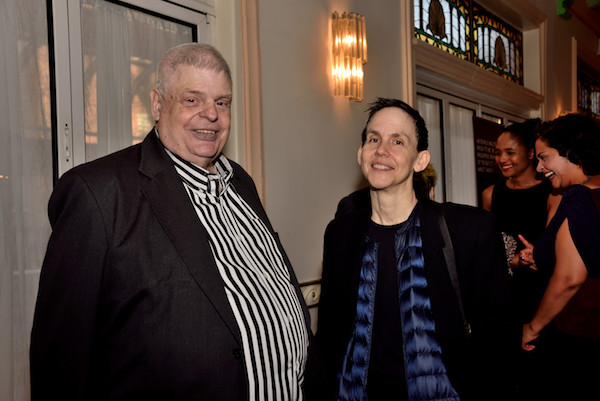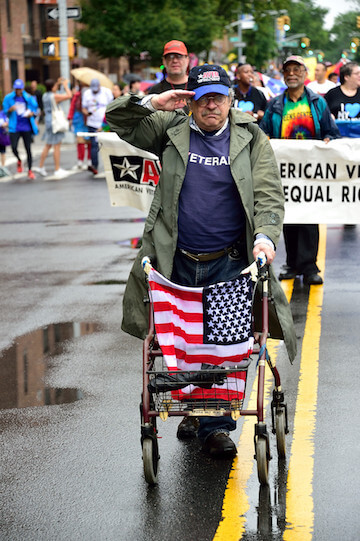Governor Andrew Cuomo at a 2015 event where he accepted the report from a task force he appointed to develop a blueprint for ending the AIDS epidemic by 2020. | GAY CITY NEWS
BY PAUL SCHINDLER | The city health department and leading AIDS advocacy groups are scrambling to convince Governor Andrew Cuomo to reverse a proposal in his new executive budget that would reduce reimbursements for local government public health spending in six core areas from 36 percent of the total to 29 percent.
According to notes on the budget prepared by the New York City Department of Health and Mental Hygiene and obtained by Gay City News, that revised formula would translate into a loss of $32.5 million dollars per year.
The DOHMH document says the formula cut would only apply in New York City, based on the governor’s assessment that the city can access other public health funding, including from the federal Centers for Disease Control and Prevention. In the notes, however, the department concludes that federal funding is, at best, uncertain under the new Trump administration — with cuts likely, the threatened repeal of the Affordable Care Act, for example, eliminating 13 percent of the CDC budget.
Department of health, striving to upgrade its sexual health clinics, fears it could lose one
A February 1 letter to the governor signed by roughly 80 AIDS advocacy and social and legal services groups pegged losses they were able to identify at $11 million per year over each of the next two years, with the bulk of those cuts falling on the city’s Ending the Epidemic and STD programs.
The letter, whose signers included ACRIA, Amida Care, the Apicha Community Health Center, the Callen-Lorde Community Health Center, Gay Men’s Health Crisis, Housing Works, the Latino Commission on AIDS, VillageCare, and VOCAL New York, noted that in 2015 the city saw an 8.5 percent decline in new HIV diagnoses to less than 2,500, the lowest in history.
Citing those figures, the advocates said New York is “at the tipping point when it comes to ending the state’s HIV/ AIDS epidemic,” under a plan that aims to reduce new HIV infections to 750 annually by 2020.
New York City accounts for more than 90 percent of new infections in the state, and hopes to lower new infections in the city to 600 per year by 2020.
The notes produced by DOHMH suggest the cuts would affect a broad array of public health services, including flu vaccinations, Zika virus efforts, drinking water testing, communicable disease oversight, anti-smoking campaigns, and distribution of naloxone kits to prevent drug overdose deaths.
The memo specifically warned that the city could lose one of its eight currently operating STD clinics, resulting in 6,000 sexually transmitted infections going untreated and at least 30 HIV-positive people going undiagnosed and untreated. In an op-ed in this issue of Gay City News, Dr. Mary Bassett, the city’s health commissioner, discusses how a step-up in services at the city’s sexual health clinics is a critical component in the effort to achieve the Plan to End AIDS’ goals.
In 2015, the city and the health department sparked intense criticism when the clinic in Chelsea, which had the greatest usage and saw the highest numbers of HIV and STD diagnoses, closed for several years for a major renovation.
Eric Sawyer, a longtime AIDS activist who recently joined Gay Men’s Health Crisis as vice president of public affairs and policy, said he ran into Bassett recently in Albany, where she told him the formula cut to what is known as Article 6 was the health department’s biggest concern in the new state budget.
According to Reed Vreeland, the policy director at Housing Works who described the formula change as a “devastating cut” in the fight to end the AIDS epidemic, advocates received no response from Cuomo’s office to their letter. With the governor’s 30-day amendments to his executive budget set for release this week it’s apparent that first-round efforts to stop the cuts have failed.
Housing Works and other advocates, however, do not appear ready to let up the pressure on Cuomo or simply rely on the Democratic Assembly to make up for the shortfall in the governor's budget, though they will likely make certain that legislators accept some responsibility themselves.
“I don’t believe the governor and his staff realized that the change in the Article 6 matching formula for New York City would overwhelmingly impact on new city investments on Ending the Epidemic and addressing sexually transmitted infections,” Charles King, Housing Works’ president, said in an email message.“It is never good policy to assume localities can simply fill a hole created in the state budget with other sources of revenue. It is incredibly bad policy when the local investment has been made to carry out the governor's own initiative. The governor and the legislature should reverse this unforced error.”
The governor’s office did not respond to a request for comment by press time.
Cuomo first endorsed the Plan to End AIDS in mid-2014, though the state did not fund the plan until 2015 and even then advocates said the amount fell well below what was needed to fully carry it out. AIDS groups, dependent on Cuomo’s help for money and legislation, have been largely unwilling to criticize him, though last year he was the object of protests in New York City and Albany, with charges he had not delivered on promises made about supportive housing for people living with HIV. Studies have shown that stable housing is a critical component in ensuring that people comply with their medication regimen, which in turn means they will be non-infectious.
Last summer, Mayor Bill de Blasio was caught short when the governor announced that the city’s HIV/ AIDS Services Administration would be required to enroll all people living with HIV rather than just those who had an AIDS diagnosis for its benefits programs, including rental assistance, without making any specific commitment on what funding the state would provide for the program’s expansion. At the time of Cuomo’s announcement, the city, which favored the expansion, and the state were involved in long-term negotiations about how to split the bill.

































